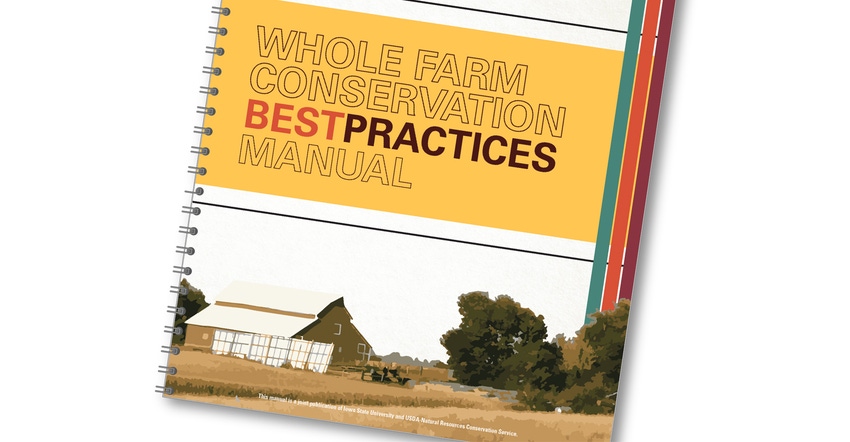October 19, 2022

Iowa State University’s Conservation Learning Group (CLG) has released a new edition of its Whole Farm Conservation Best Practices Manual, with updates and new conservation practice information. The material is geared toward aiding Iowa farmers and landowners to investigate and implement conservation practices that align with their landscape, conservation objectives and business needs. The manual is available at no charge in electronic and print formats.
Designed as a hands-on working document, the manual was created in cooperation with the Iowa Soybean Association, Iowa Agriculture Water Alliance and Practical Farmers of Iowa, and with the support and input from multiple local, state and federal organizations.
“We’ve had tremendous feedback from farmers, landowners and conservation professionals who have used the first edition of the manual for research, education and practical assessments of which practices fit their land and goals," says Matt Helmers, ISU professor and director of the Iowa Nutrient Research Center. “This edition incorporates feedback from users as well as additional practices which could prove fruitful for many farmers and landowners.”
Practices
New conservation practices in the manual include multipurpose oxbows, windbreaks, riparian forest buffers and bottomland timber establishment. Sections covering practices such as cover crops, no-till, terraces, ponds, water and sediment-control basins, and grassed waterways also include expanded detailed information.
Each conservation practice profiled in the manual is covered in detail regarding fit for land type; conservation goals such as reduction in nitrogen (N) or phosphorus (P), soil health and wildlife habitat.
“One of the most useful aspects of the manual is the inclusion of decision worksheets that provide a step-by-step analysis and decision-making pathway that can be utilized to better understand what will and will not work for any given farm or field,” Helmers says. “Our partners and field day participants have given these tear-out graphical decision tools high praise and offered ideas to make them even more effective.”
New information
Significant changes to the manual include the designation of practices with regards to impact on N and P loss — impacts to further clarify which nutrient each practice is focused on, and the relocation of decision tools designed for conservation professionals.
“The decision tools and resources for conservation professionals have been expanded and moved to an online reference repository to facilitate access to desired information,” Helmers says. “Typically, these professionals are looking for specific information, and we felt it would be more efficient for them to pull what they need for each project.”
The new section of multipurpose oxbows details the use of these common Iowa land features to slow and store field runoff, offering opportunities for catchment of sediment and nutrients.
The addition of forestry-related practices extends the library of edge-of-field practices to include approaches that are not often first-of-mind in considering conservation deployments.
“Often overlooked in conservation planning, windbreaks have proven to not only decrease soil erosion, but also to increase some cash crop yields,” says Billy Beck, assistant professor and Extension forestry specialist at ISU. “Planning, establishing and maintaining riparian forests and bottomland timberlands can have long-reaching effects on water quality, biodiversity and overall farm productivity. Including these practices in the manual should help expand conservation thinking and planning in many positive ways.”
Get your free copy today
Designed primarily for farmers just starting out through three years of adopting conservation practices, the manual provides a broad range of information that could be beneficial to any farm producer. The manual is available for free download or in hard copy from the ISU Extension Store ISU Extension Store.
The online Addendum: Decision Tools for Conservation Professionals is available for free download from the Conservation Learning Group website.
Organizations contributing to the development and production of these materials include ISU Extension and Outreach, USDA Agricultural Research Service, Practical Farmers of Iowa, Iowa Soybean Association, Iowa Agriculture Water Alliance, and the Soil and Water Conservation Society.
This manual is a joint publication of Iowa State University and USDA Natural Resources Conservation Service, supported by the Natural Resources Conservation Service, USDA, under No. 6000004181.
Ripley is Iowa Learning Farms manager and a Water Rocks conservation outreach specialist. To learn more about Conservation Learning Group, visit conservationlearninggroup.org.
About the Author(s)
You May Also Like




